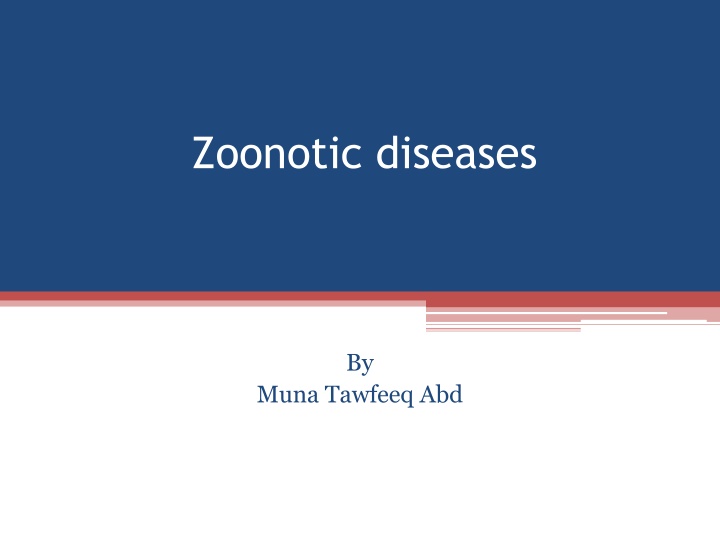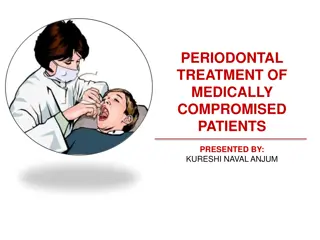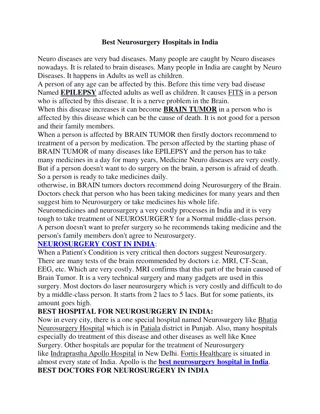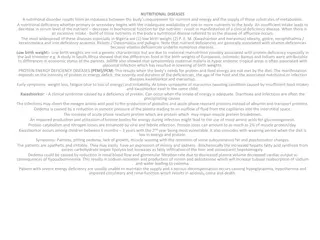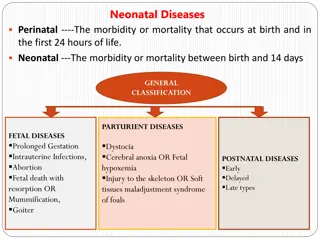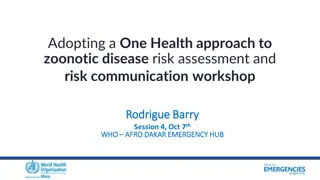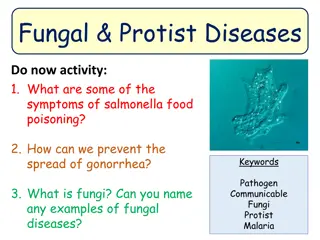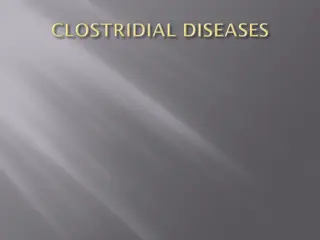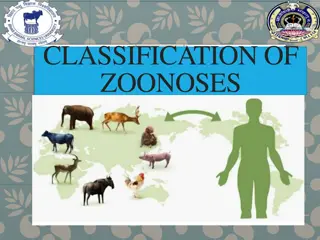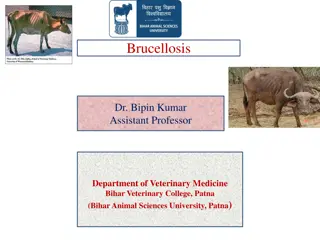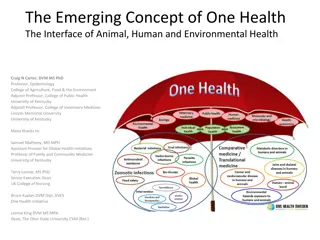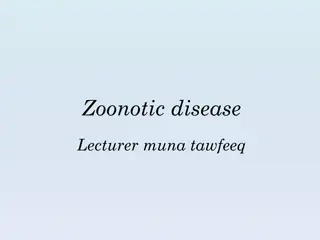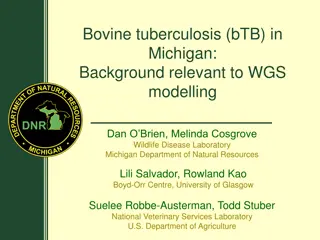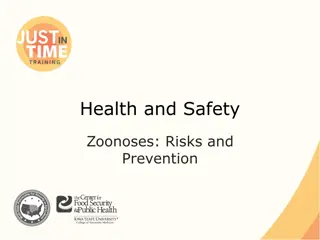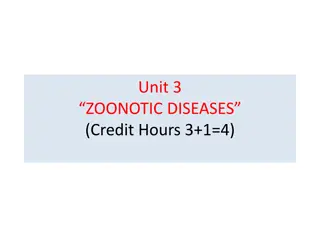Zoonotic diseases
Zoonotic diseases refer to illnesses transmissible between animals and humans, encompassing various pathogens like viruses, bacteria, parasites, prions, and fungi. With 1,415 species known to be pathogenic to humans, including viruses, bacteria, fungi, protozoa, and helminths, it's crucial to understand the dynamics of zoonoses. This includes reverse zoonoses where diseases transfer from humans to animals and back, as well as emerging zoonotic diseases like Bird flu, AIDS, and Mad cow disease. Various factors influence the emergence of zoonoses, ranging from molecular mechanisms like genetic drift to social and ecological conditions impacting population dynamics. Understanding zoonotic disease transmission involves identifying sources of pathogens, susceptible hosts, and means of microbial spread.
Download Presentation

Please find below an Image/Link to download the presentation.
The content on the website is provided AS IS for your information and personal use only. It may not be sold, licensed, or shared on other websites without obtaining consent from the author.If you encounter any issues during the download, it is possible that the publisher has removed the file from their server.
You are allowed to download the files provided on this website for personal or commercial use, subject to the condition that they are used lawfully. All files are the property of their respective owners.
The content on the website is provided AS IS for your information and personal use only. It may not be sold, licensed, or shared on other websites without obtaining consent from the author.
E N D
Presentation Transcript
Zoonotic diseases By Muna Tawfeeq Abd
Zoonotic Diseases any disease and/or infection which is naturally transmissible directly or indirectly between animal and humans . From the Greek: Zoon: Animal, Noson:Disease. Infectious diseases are caused by pathogenic microbes (viruses, bacteria) or by parasites (worms, protozoans) ,by prions ,rickettsia and fungi.
1,415 species of infectious organisms known to be pathogenic to human, including 217 virus and prions, 538 bacteria and rickettsia, 307 fungi, 66 protozoa and 287 helminths. Out of these 868 (61%) were classified as zoonotic and 175 pathogenic species were associated with emerging disease. Of this group of 175 emerging pathogens 132 (75%) were zoonotic
Type of Zoonoses Reverse Zoonoses: Infectious disease of people occasionally transferred to animals and then transferred back to people is termed as reverse zoonoses . Examples are Tuberculosis , Mumps, Streptococcus pyogenes, infectious hepatitis, coryne bacterium diphtheria .
Emerging zoonotic disease: About 75% of emerging human infectious diseases are (Zoonotic diseases). The recent emerging zoonoses, for example are Bird flu, AIDS, Mad cow disease and the Nipah virus. A disease that has appeared in a human population for the first time A disease that has occurred previously but is increasing in incidence (number of new cases) A disease that is expanding into areas where it had not been reported in the past 20 years
Factors Influencing Emerging Zoonoses Factors explaining the emergence of a zoonotic or potentially zoonotic disease are usually complex, involving mechanisms at the molecular level, such as genetic drift and shift, as it occurs in avian influenza virus and modification of the immunological status of individuals and population. Social and ecological conditions influencing population growth and movement, food habits, the environment and many other factors may play a more important role than changes at the molecular level.
Zoonotic disease transmission Transmission of infection requires three elements: a 1. source of pathogens, 2. a susceptible host 3. and a means of transmission for the microorganism
Source: Include animal or environment contaminated by animals. Pathogens may be transmitted to humans directly from the animal via blood or other body substances during diagnostic or treatment procedures or indirectly from the animal s environment.
Host Susceptibility: Animal may be clinically ill, asymptomatic carrier of an infectious agent, harbor endogenous flora that are pathogenic to human or in the incubation period of an infectious disease. Host resistance to pathogenic microorganism varies greatly. Some people may be immune to infection or may be able to resist colonization by an infectious agent. Others exposed to the asymptomatic carriers, while still others may develop clinical disease. same agent may become
Host factors such as age, underlying disease, immunosuppression, irradiation, pregnancy and breaks in the body s first line of defense mechanism (intact skin, cough, reflex, stomach acid) may render a host more susceptible to infection.
Route of Transmission: Transmissions occur through three main mechanisms, direct or indirect contact, aerosol and vector borne. The same agent may be transmitted by more than one route. Transmission is largely influenced by the stability of the pathogen, its virulence and the route by which it leaves the infected host.
Routes of transmission Pathogens can be transmitted from animals to humans and vice versa in many different ways: 1. direct contact between man and animal 2. Indirectly via food of animal origin 3. Indirectly via water and soil 4. Indirectly via insects, ticks, or rats/mice
People at risk Some people run more risk of becoming infected with zoonoses than others. They can be divided into three main groups as follows: Professional contacts: farmers, butchers, veterinarians or others whose work brings them into intensive contact with animals or animal-products Young children, elderly, and HIV infected persons, more vulnerable due to a less effective immune system Pregnant women
Significance of zoonotic diseases Humans: may have various consequences including the following cost for diagnosis of the diseases, medical fees and cost of hospitalization, nursing and drugs, loss of working days or production, mortality, suffering and social consequences of disability and abandonment of farming or agricultural activities by affected or at risk persons. It has been observed that some zoonoses (e.g. cystic echinococcosis) may negatively affect the quality of life and that the affected patients have higher unemployment rate in comparison to the general population
Livestock: in livestock the following negative consequence of zoonoses may be considered: reduced yield and quality of animal production (meat, milk, eggs, and labor), reduced birth rate and fertility, delayed performance and growth and in some cases condemnation of organ and cost for destruction of viscera
Recognition of zoonotic diseases: method of assessing new disease involves Clinical recognition. Some astute individual or group of 1. people recognizes a disorder that is not typical of any known disorder. It may be an atypical presentation for a previously described disease, or it may be a new disease. In order to foster such recognition, it is helpful to educate emergency room physicians, hospital infectious disease experts, and other individuals in the line of battle to the possibility of a new disease or one not previously encountered in the region.
2. Standard laboratory assessments. An important finding may occur as a result of clinical recognition when special attention is given to laboratory analyses of material from subjects identified as having an unusual presentation or when astute laboratory personnel notice something unexpected in material from a patient(s) not yet considered to have an unusual disorder. 3. epidemiology studies. These studies may disclose the geographic region encompassed by the new disorder; the age, gender, and races of susceptible individuals; the immune status of resistant and susceptible individuals; potential vectors or animal hosts; and the incubation period and modes of transmission.
4. Laboratory tests. When there is evidence of a new and important disease, all possible laboratory tests should be done early in the process. These tests include: -Microscopy. -Electron microscopy. -Culture. Culture everything all mucosal surfaces, all secretions and excretions, including: Bacteria both routine and special cultures. Viral cultures. Rickettsial cultures. -Measurement of antibody titers in host sera. -Antigen capture assays. Use antibodies to putative agents to identify potential pathogens. -Nucleic acid amplification (RNA, DNA) by probe hydrolysis PCR or reverse transcriptase PCR and use of chip arrays. -Mass spectrometry. -Genetic analyses prions, etc. -Inoculation of test animals. :
Veterinarians involved in controlling zoonotic diseases: Deworming animals for parasitic zoonotic diseases Vaccinating of animals for viral zoonotic diseases Diagnosing and treating diseased animals Educating pet owners about zoonotic diseases Participating in disease eradication programs Inspecting Meat
General ways to protect yourself from zoonotic diseases: Wash your hands before eating and after touching an animal. Never approach a wild animal or a domestic animal (for example, dog or cat) that you don t know. Never handle the stool of any animal without wearing disposable gloves or using a plastic barrier. Wear insect repellent to avoid being bitten by mosquitoes. Eat only well cooked meat and eggs and drink pasteurized milk. Make sure that your pets get regular check-ups and vaccinations. Wash your hands after gardening or working in soil where pets may have relieved themselves
